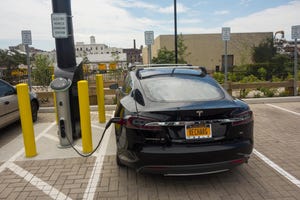AT&T, T-Mobile and Verizon outline their FWA, fiber expansion plans
Each of the big US telco operators plans to expand the reach of its broadband home Internet offerings via a combination of fiber and fixed wireless. How that might affect cable providers remains to be seen.

Each of the big telco operators in the US – Verizon, T-Mobile and AT&T – plans to expand the reach of its broadband home Internet service in the coming years. Further, each company plans to do so via a combination of fiber and fixed wireless access (FWA) connections.
Moreover, those efforts could be supercharged if the operators tap into subsidies from the US government. US states are currently in the process of allocating $42.5 billion in Broadband Equity Access and Deployment (BEAD) money, with initial network-construction projects expected to start next year.
Broadly, the companies' efforts could put further pressure on US cable companies like Comcast and Charter Communications that have recently seen a slowdown in their core business of broadband home Internet service.
But there are headwinds. For example, the US government's Affordable Connectivity Program (ACP) – which provides a $30/month broadband subsidy for over 23 million low-income households – is on track to run out of funding in just a few months. That would likely reduce the number of customers signing up for new connections. Further, the cost of telecom equipment, particularly fiber equipment, continues to rise, according to one survey.
Regardless, executives with AT&T, T-Mobile and Verizon sounded relatively optimistic about their FWA and fiber expansion plans.
T-Mobile
Importantly, T-Mobile officials suggested that, after trials of the technology, the operator is getting closer to implementing a broader fiber play. That effort would represent a significant development for T-Mobile because – unlike AT&T and Verizon – T-Mobile does not own a wired network. Instead, its wireless network essentially rents backhaul space on fiber networks owned by other companies.
But that hasn't stopped T-Mobile from exploring the world of fiber home Internet services. As Light Reading has previously reported, T-Mobile is buying wholesale connections on fiber networks from regional open access operators like Tillman FiberCo, SiFi Networks, Intrepid Networks and Pilot Network in order to offer T-Mobile-branded fiber Internet connections. According to T-Mobile's fiber website, the operator is now offering three tiers of fiber service, starting at 500 Mbit/s connections for $55 per month and ranging up to 2 Gbit/s services for $100 per month.
"We're really pleased with how those are going," Mike Katz, T-Mobile's president of marketing, strategy, and products, said at a recent investor event. T-Mobile officials have described T-Mobile's open access fiber partnerships as a "capital light" way for T-Mobile to play in the fiber industry.
"If we did something in fiber, it would be in a more capital-light structure, probably in a partnership with somebody else. But that, I would say, is looking more and more likely that we would do something there," Katz said this week, without providing details.
Those comments come as T-Mobile throttles its FWA growth. The company has signaled that it expects its FWA net customer additions to slow to 400,000 quarterly, down from 500,000 during the past year or two.
Broadly, T-Mobile officials have said the company remains on track to expand its FWA service to 7-8 million customers by 2025. And company officials suggested T-Mobile could grow beyond those figures with additional investments into millimeter wave spectrum infrastructure, external antennas or other equipment. Along those lines, T-Mobile this week announced it would put its Auction 108 spectrum winnings into action.
"The team is certainly exploring everything," Katz said.
AT&T
AT&T COO Jeff McElfresh said this week that the company remains on track to expand its fiber network to 30 million locations by 2025. The company is in the process of replacing large portions of its aging DSL copper network with a combination of fixed wireless and fiber.
But McElfresh reiterated that AT&T's fiber ambitions may stretch beyond that 30 million total. "As we look further, though, we know that there are 10 million to 15 million incremental locations that are attractive. They meet the return characteristics that we have been currently building against," he said at an investor event this week.
McElfresh explained that AT&T has identified an additional 10-15 million locations that feature the same economic characteristics as the 30 million locations that AT&T is currently planning to touch with fiber. He said that, after AT&T reaches its 30 million target in 2025, the company might continue building fiber to more locations within that 10-15 million range. He said the company might do so with BEAD money or through partnerships like the kind it inked with BlackRock.
As for FWA, McElfresh said the company will be "deliberate" in how it expands its new fixed wireless Internet service, but he declined to provide specifics. The financial analysts at New Street Research recently forecast that AT&T would hit a peak of 180,000 FWA subscriber additions per quarter by late 2025.
Verizon
Verizon's networking chief Joe Russo said this week that the company remains on track to hit its goal of between 4 million and 5 million FWA customers by 2025. But he also suggested the company could grow beyond that figure.
"I see tremendous upside in our wireless technology," Russo said at an investor event, in response to a question about Verizon's FWA network capacity. "Unlike copper, that has all sorts of physical constraints to it, I don't see the same in the wireless space."
Indeed, Verizon hasn't yet lit up all its midband C-band spectrum holdings in many US rural markets, and will do so over the next few years. That effort ought to allow the company to sell FWA into significantly more locations than it does today. After all, FWA offerings in the US primarily run over the capacity available on midband spectrum like the C-band.
As for fiber, Russo said Verizon would continue to expand its Fios fiber network to roughly 400,000 new locations every year. He also said that figure "may go up or down" based on whether Verizon wins BEAD funding.
About the Author(s)
You May Also Like












